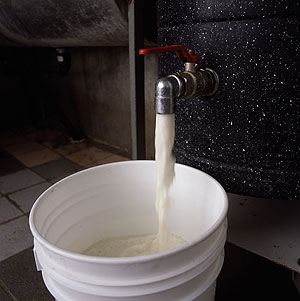Healthy Calf Conference
Follow to stay up-to-date on all Healthy Calf Conference updates. Speaker announcements, sponsorship information, registration announcements, and more.
Bloat in calves is most frequently seen in the first one to two weeks of life. Calves may refuse milk, have a distended abdomen (right side or both sides), grind their teeth, kick at their belly, become depressed or lethargic, have droopy ears, and may die suddenly. The time between the first signs of bloat and death can be as little as four hours. Any calf that dies suddenly without explanation should be necropsied (examined by a veterinarian after death) to determine the cause of death and prevent additional cases. In the case of bloat, there are several ways to adjust calf management to prevent additional cases.
When adult cattle bloat, gas becomes trapped in the rumen (the first of the four stomach compartments). Often, passing a tube through the mouth into the rumen can release the gas and provide relief. However, when calves bloat, gas is trapped in the abomasum (the last of the four stomach compartments). This means that tubing them will not help release the gas, as a tube cannot pass from the mouth through the entire stomach and into the abomasum. It is also ill-advised to insert a needle into the calf’s side to release the gas, as this could cause stomach contents to leak into the calf’s abdomen. This can lead to infection and sepsis. Sepsis causes organ damage and inflammation throughout the body, which can kill the calf. Work with your veterinarian to create a protocol for managing bloat in calves, which may include instructions to call your veterinarian immediately if you notice a calf with signs of bloat. Bloat can kill a calf quickly if there is any delay in diagnosis or getting veterinary attention. Not all calves will respond to treatment, and catching cases before they turn deadly can be a challenge. For these reasons, preventing bloat is the best way to prevent calf loss.
While there is no consensus on exactly what causes bloat, there are several management practices that can increase or decrease the risk of calf bloat. Here are a few tips on preventing bloat on your farm:
The feeding amount, schedule, mixing, water temperature, and milk temperature at delivery (aim for 38°C) should all be consistent each day. Weigh the powder using a scale (don’t measure in a cup), and measure water carefully. Make changes gradually when required and be sure all staff is trained to feed consistently.
High osmotic concentration (ratio of solids in a liquid) in electrolyte products and milk replacers can cause bloat. Adding more milk replacer powder than directed by the label can lead to high osmotic concentrations. Always follow label directions unless otherwise directed by your herd veterinarian or nutritionist. Don’t feed products with an osmotic concentration of more than 600 mOsm/L or total solids of over fifteen percent. Total solids can be measured easily on farm with a Brix refractometer.

If looking to increase milk replacer offered to calves to improve growth or to help them thrive in winter, switch to a milk replacer formulation specifically designed for that purpose. Don’t just increase the amount of conventional powder in the same volume of water.
A benefit to feeding milk replacer over whole milk is that milk replacer has a much more consistent nutrition level. Work with your nutritionist if you are feeding whole milk and encountering problems with bloat before adding any milk replacer or balancers (powdered product intended to increase/balance nutritional value of whole milk) to whole milk.
In addition to other benefits, such as increasing starter intake, the availability of fresh, clean water can reduce the risk of bloat.
A large, single daily feeding can upset calves’ digestive tracts. Two feeds are better, but three or more smaller, consistent meals are best if this works with your operation’s schedule. Automatic feeders are great for offering calves multiple meals without added labour.
Failure of passive transfer can increase the risk of bloat. See calfcare.ca for many articles on the importance and benefits of colostrum.
Feeding plant-based milk replacers could also cause digestive problems in calves. Calves less than three weeks old should be fed whey protein-based milk replacers, while older calves can be fed plant-based formulations with more success.
If calves are being fed electrolytes, the best practice is to add electrolyte feedings between milk meals. Don’t mix milk/ milk replacer and electrolytes. When calves are being fed electrolytes to replenish lost fluids, condensing milk replacer and electrolytes into one meal will not benefit the calf. Feed milk and electrolytes in separate feedings.
Preventing heat and cold stress can help reduce the risk of bloat.
Sudden deaths caused by bloat are an avoidable occurrence if calves are well-managed. Being sure to have set calf care routines and ensuring they are followed consistently and completely will improve overall calf health, welfare, and growth.
Follow to stay up-to-date on all Healthy Calf Conference updates. Speaker announcements, sponsorship information, registration announcements, and more.
The Codes of Practice are nationally developed guidelines for the care and handling of farm animals. They serve as our national understanding of animal care requirements and recommended practices.